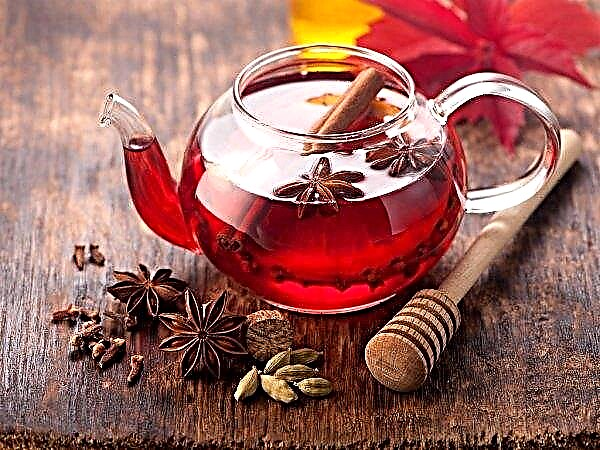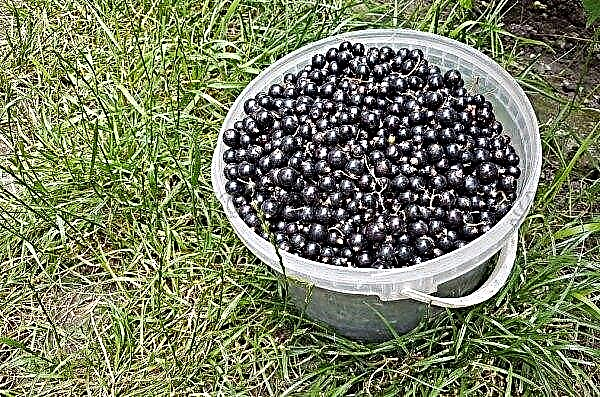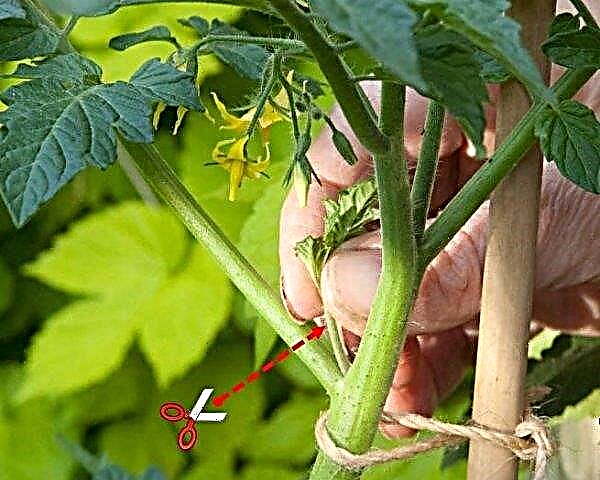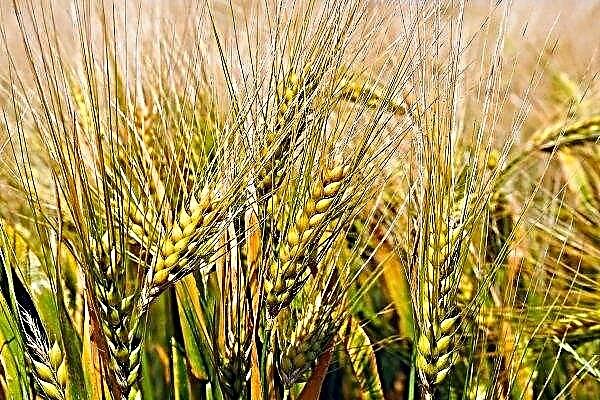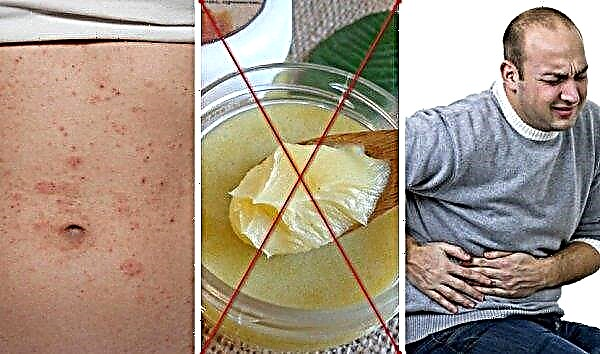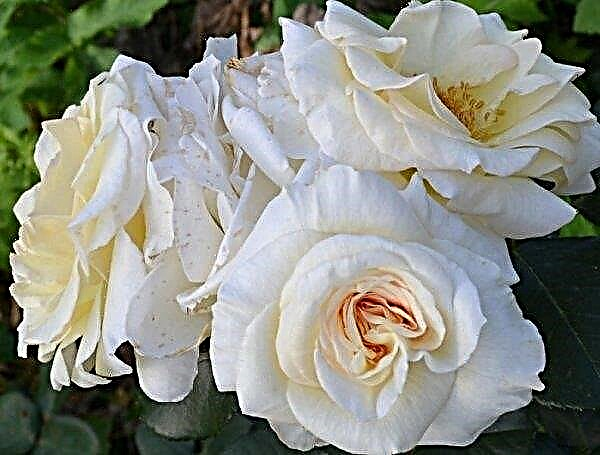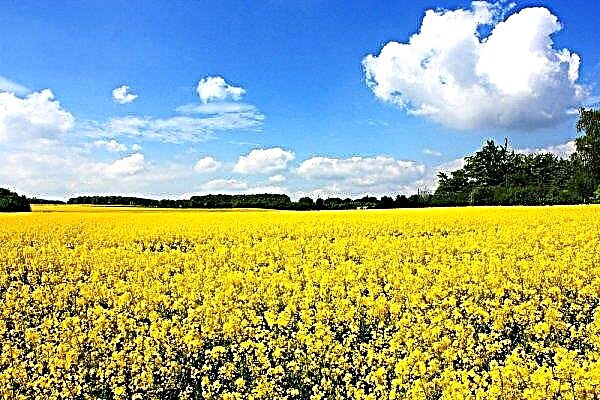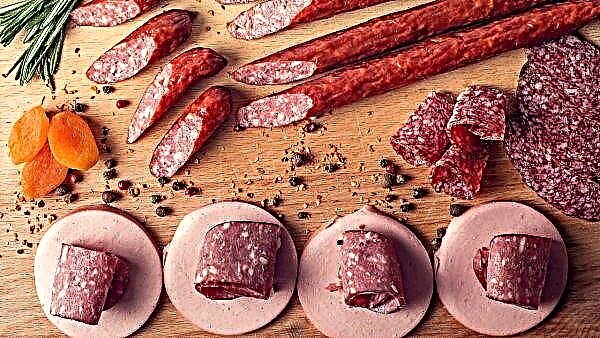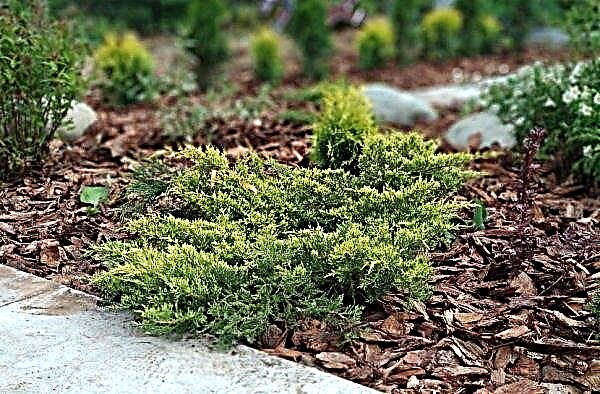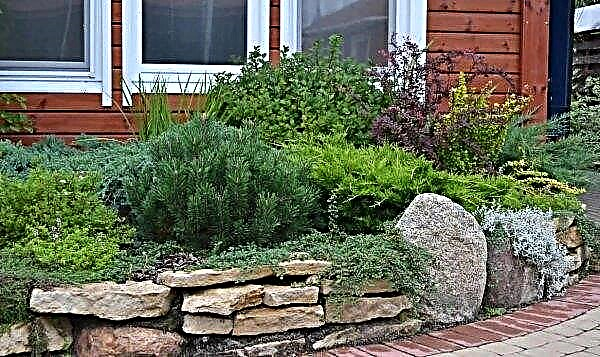The tropical hoya plant is known among gardeners as wax ivy. The birthplace of the plant is the woodlands of Australia. Hoya is found in the wildlife of Polynesia and in Southeast Asia. In indoor conditions, it is grown due to beautiful flowering and curly green branches. Consider the detailed characteristics of the flower, the necessary microclimate conditions for its cultivation, as well as the subtleties of care, transplantation and reproduction of hoya.
What does a hoya flower look like?
Hoya refers to creeping or hanging evergreen shrubs and shrubs. Thanks to the winding branches, it can be shaped into different shapes with the help of supports. In the interior of the room, the plant looks massive and can be grown in pots or in ampels.
Did you know? Hoya received an official name from researcher Robert Brown. He named the flower in honor of his friend Thomas Hoy, a gardener from the greenhouses of the Duke of Northumberland.
Consider the characteristics of the appearance of wax ivy:
- The height of different varieties is from 15 cm to 2 m.
- The roots are poorly developed and grow slowly.
- The stalk is dense and winding.
- The branches are long and thin, wrap around objects and supports, near which they grow. Their length can reach 10 m.
- For a year, various varieties of hoya can add in growth from 12 to 45 cm.
- The leaves are of medium thickness, leathery and dense, with a pointed tip. Their color in different varieties may be dark green or mottled.
- The shape and size of the leaves vary from oval and long to small and heart-shaped.
- Flowering occurs in the spring-summer period and lasts 5-7 days. The young hoya is weak. Lush and numerous inflorescences appear only in a plant that has managed to grow green mass.
- The flowers have the shape of a five-pointed star with a contrasting little star in the center - a crown. They are collected in lush hanging umbellate or round inflorescences.
- The size of the flower varies from 1.5 cm to 8 cm, depending on the variety.
- The color of the flowers depends on the variety and can be white, red, yellow or pink.
- Each variety has its own specific aroma that the flower exudes at night.
- Belongs to poisonous plants. The poison is contained in the plant's juice, stem and flowers.
Main types
Hoya indoor plant has many species, differing among themselves in the shape and color of leaves, the appearance of inflorescences, as well as growing conditions.
Important! In order to provide the required type of wax ivy with the necessary care, it is necessary to study the characteristics of the variety and its requirements for the microclimate.
The most famous varieties of wax ivy:
- Meaty hoya (wax) - Curly evergreen. It has thick, oblong leaves of medium size, painted in dark green. The surface of the sheet is covered with a wax coating, on which silver marks are clearly visible. The flowers are white, have a pink crown and a strong aroma, collected in a rosette.

- Hoya is beautiful - branched undersized shrub with side hanging shoots. The leaves are small, egg-shaped, have a green or mottled color and densely cover the stems. Inflorescences are umbrellas made of small white flowers with a raspberry middle.
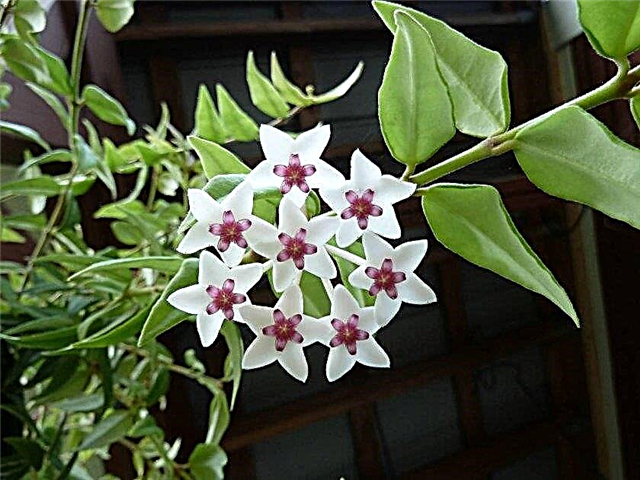
- Hoya multi-flowered (multiflora) - climbing plant with elongated leaves. Inflorescences are umbrellas from several yellow flowers with long narrow petals and a crown.

- Majestic hoya - shrub with pubescent cuttings and side shoots. Oval leaves are smooth and long. Umbrellas of inflorescences exude a strong aroma. The outer part of the flowers is yellow-green, and the inside is dark red.

- Concave Hoya (Lacunose) - consists of cascading branches with dense dark green foliage. The leaves are rhombus-shaped with inwardly curled edges. The flowers in the umbrellas have a yellow center and a white fleecy corolla.
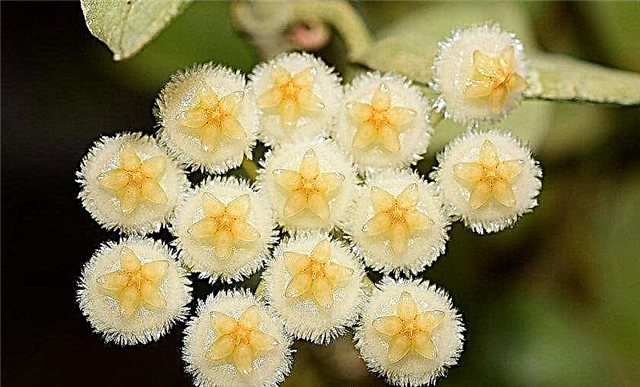
- Hoya Kerry - has long stems with dense green leaves of a heart-shaped shape. Flowers are pubescent and collected in voluminous round inflorescences. The flowers have a light color, but eventually acquire a red-brown color as a result of aging and darkening of the nectar inside them.

House growing conditions
Hoya perfectly takes root in the standard microclimate of offices, residential apartments and houses. The flower grows in a warm, brightly lit room and does not require specific conditions for growing. But for proper placement, you need to analyze the characteristics of the selected variety of hoya to create a suitable microclimate for the plant.
Lighting
The plant needs to be grown in a well-lit room, then it will delight regular flowering. But depending on the type of leaves and their colors, different types of hoya require a different amount of sunlight.
Did you know? Of all plant varieties, the largest flowers are majestic Hoya (Imperialis). The diameter of the flower is 6–8 cm
Consider the basic requirements for lighting ivy wax:
- Hoya varieties with succulent leaves or pubescent foliage of a light shade should be kept under bright sunlight and shaded only in the summer (they are grown on the southern windows);
- varieties of hoya with thin or pubescent leaves of dark color need partial shade (they need to be protected from direct sunlight and grown on eastern or western windows).

With the wrong choice of the hoya lighting system, its leaves may languish or get sunburn. Therefore, you need to position the flower on the windowsill, taking into account the requirements of each species for lighting.
Ventilation
To maintain air humidity that is comfortable for hoya and make the room less hot and stuffy, you need to ventilate it regularly. At the same time, drafts should not be allowed.
The flower loves fresh air, but it is not recommended to take the hoya outside in cold weather. Airing provides the flow of fresh air necessary for the hoya and prevents the occurrence of fungal diseases.
Temperature mode
Hoya belongs to thermophilic plants. In summer, the temperature comfortable for her is +20 ... + 25 ° С. In winter, the flower can be grown in a cooler room with a temperature of about + 15 ° C. The minimum temperature that the plant can withstand is + 10 ° C.
Important! In a room that is too cold, the hoya can get sick with fungal diseases or start dropping leaves.
Air humidity
Hoya is resistant to low humidity, but pests can appear on the flower in a too dry room. The optimal indicator of air humidity for a flower is 50-60%.
It is recommended to place the hoya near decorative indoor fountains or on a pallet with wet expanded clay. In the warm season, you need to regularly spray the plant with water and wipe the leaves with a damp sponge every week. When spraying, water should not fall on the inflorescences.
How to care at home?
Each of the above varieties in the natural environment grows in different climatic conditions. Therefore, each grade requires a different care, consisting of proper watering, fertilizing, pruning and transplanting. Consider the rules for caring for various types of wax ivy in more detail.
Watering
There is a general rule for all plant varieties - you cannot water the flower too abundantly, turning the soil in the pot into a semi-liquid mass. As a result of such overmoistening of the soil, root rot develops in the hoya, which can destroy the plant.
According to the amount of water consumed and the frequency of irrigation, different varieties of hoya differ from each other.
Rules for watering a flower:
- varieties with succulent leaves should be watered sparingly, allowing the top layer of the earth to dry out a little;
- varieties with thin and pubescent foliage need regular and plentiful watering, they respond poorly to drying out of the soil in a pot;
- watered under the root;
- you can use only water at room temperature, previously it is allowed to settle. Rain or boiled water is also suitable;
- in the summer and spring months, the flower should be watered every 3-4 days. In winter, a plant needs only one watering of 7-10 days;
- in the spring and summer months, plants are regularly sprayed with water.
Bathing
Hoya is useful for regular bathing in spring and autumn, when the period of active growth of the plant begins. A flower is bathed before and after flowering.
Important! During flowering, you can not bathe a hoya - this can provoke a dump of buds.
Wax ivy can be bathed in one of the following ways:
- put a flower under a warm shower in the bathroom, but you must always cover the earth in the pot so that it does not get wet from the water;
- lower the plant into a basin with warm water (about + 40 ° C) together with the pot for 30–40 minutes;
- briefly expose the hoya in the warm summer rain, if it is not too strong and there is no wind on the street.
After bathing, the leaves of the flower become even more attractive, shiny and resilient.
Fertilizer application
The plant needs nutritious soil for lush flowering and normal growth. If you periodically transplant the flower into fresh soil, then the substances contained in it will be enough. In other cases, you need to use top dressing.

Fertilizer application rules:
- for all varieties of hoya, you can use universal fertilizers for flowering succulents;
- during the fast growth phase, the plant needs nitrogen fertilizers;
- in the spring-summer period, wax ivy spends a lot of energy on growth and flowering, so fertilizers must be applied every 10-14 days;
- in winter, the flower slows down growth; therefore, top dressing is applied no more often than every 30–35 days;
- at any time of the year, fertilizers are applied in a concentration that is 2 times less than that indicated on the package.
If in winter the hoya is kept in a cool room and slows down growth, then fertilizers can be omitted.
Pruning
Hoya doesn't like pruning. But dried leaves and branches, as well as old shoots need to be cut, as they spoil the decorative appearance of the plant. Removing old branches and leaves is best done while bathing the plants in the shower. You can trim the side shoots on which no flowers have formed.
Important! Cutting should be done with gloves so that poisonous juice does not get on the skin of the hands.
During the flowering of the hoya, pruning is not performed and they try not to move the plant so that the buds do not fall off. Peduncles cannot be pruned even after the flowering period has ended. After a year, inflorescences may form on them again. This process can be repeated 2-3 times.
Transfer
It is better to transplant hoya to fresh land in spring. For young plants, this procedure is required every year. Adults can be transplanted less often - every 2-3 years.

For a flower transplant, use only a new pot, thoroughly washed with soap.
The soil for wax ivy should have the following characteristics:
- high breathability;
- weak or neutral acidity;
- mandatory pre-sterilization - soil calcination in the oven;
- the presence of a drainage layer to prevent stagnation of water.
The composition of the soil depends on the variety of flower. Florists often use a substrate for orchids or garden soil.
For hoya, the soil of this composition is suitable:
- clay-turf substrate - 50%;
- sheet land - 25%;
- humus - 25%.
Step-by-step instructions for a flower transplant:
- Sterilize the soil for the plant, prepare a new pot.
- At the bottom of the tank lay a layer of drainage and sprinkle some earth.
- Carefully remove the hoya from the old flowerpot along with the earth adhering to its roots.
- Transfer the plant to a new container. Sprinkle the roots on top of the soil.
Video: Hoya Transplant
Breeding
The plant is propagated by three methods: layering, cuttings and seeds. The latter is the most time-consuming and rarely used. Hoya flowers require proper planting and care during the rooting of young plants. Let's consider step-by-step instructions for propagating a flower.
Did you know? At Hoya Kerry, the color of the flowers depends on the lighting in the room and can vary from light lemon to pale pink.
Layering
This method of reproduction is simple and convenient. If the procedure is carried out correctly and the young plant has a good microclimate, it can bloom in the year of planting.

Step-by-step instructions for the reproduction of wax ivy with air layers:
- Make an incision on the lateral shoot of the plant. You can treat it with a solution of a root growth stimulator.
- Fill the incision site with wet sphagnum moss and cover with plastic wrap or bag. Keep the plant at a temperature of about + 22 ° C and in good light.
- After 2-3 weeks, small roots grow at the cut site. At this point, you need to carefully cut the branch from the mother plant and transplant into an individual pot.
- Hoya can be propagated by air layers in another way. To do this, fix the side shoot in a separate container with moistened moss and wait for the roots to appear.
- After rooting, the shoot is separated from the mother plant and grown in a separate pot.
Cuttings
Propagation of hoya by cuttings is simple; they easily take root in water or a loose substrate.
This method of reproduction is used by beginner growers:
- Cut a short stalk with 2-3 nodes and several leaves from the parent plant.
- Rinse the cut-off site with a root growth stimulator.
- To root the cuttings in the soil, prepare a container and fill it with earth.
- Immerse the cut of the cut in the ground so that the bottom node is in the ground.
- To increase the moisture around the handle, a plastic bag is put on it. The bottom of the bag should let air through, so it’s not tied.
- The container with the handle is placed in a warm room (about + 22 ° C) with bright lighting.
- The soil with the planted cuttings is watered as the top layer dries. It is impossible to fill the earth with water too much.
- Root formation lasts 2-3 weeks. After this, the stalk begins to grow noticeably and produce new leaves.

You can root the stalk in a jar of water. The neck, walls and bottom of the container are wrapped with foil, making small holes above the neck. Cuttings are lowered in them so that water covers their lower node. The part of the cuttings located above the foil is slightly covered with a plastic bag and put in a warm bright place. After 10-14 days, small roots appear on the cuttings cuttings, then they are transplanted into the soil.
Important! Transplanting the cuttings into a permanent pot should be done immediately after the appearance of small roots. If tightened with this procedure, the stalk will become too fragile and may break.
Seed cultivation
It is rarely used, since it is difficult to find ready-made hoya seeds for sale, as well as to get them at home.
Consider the step-by-step instructions for planting flower seeds:
- Dry seed. Use only mature seeds collected in the same year in which they are planted.
- Prepare a container with a loose mixture of earth and sphagnum moss.
- Deepen the seeds and sprinkle lightly with soil.
- Put the container in a warm place with good lighting for seed germination. You can cover the seedlings with film or glass. Seeds germinate in 5–7 days.
- After the emergence of the sprouts, remove the shelter from the tank and provide seedlings with regular watering. The soil should always be slightly moist.
- Spray the sprouts with copper-containing preparations according to the instructions indicated on the package. This will help prevent fungal diseases.
- Keep the seedling container in a warm room without drafts, under bright diffused lighting.
- After 3 months, 3-4 sprouts appear on the sprouts. At this time, they can be transplanted into individual pots.

Growing difficulties
Hoya is not prone to illness under conditions of proper care.Problems with the plant begin when the lighting and watering conditions are violated, the room is too cold or dry, and the flower lacks fertilizer.
Possible difficulties in growing hoya:
- Scaffold, spider mite, aphid. These pests infect the leaves of the flower and multiply well in dry air. If there are few insects, it is enough to remove them from the plant with a cotton swab dipped in alcohol. When the number of pests is large, then they are sprayed with insecticides according to the instructions indicated on the package of the drug.
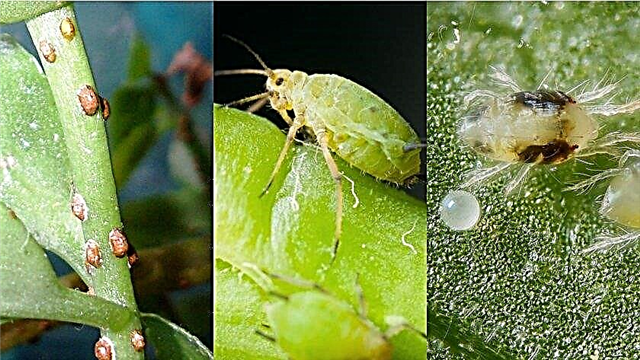 Scabbard, aphid and spider mite
Scabbard, aphid and spider mite - Root nematode. Signs of defeat by this pest are stunting and yellow-brown patches on the roots. The flower must be removed from the pot, rinse the roots in warm water with a temperature of + 50 ° C and treat with an insecticide. After this, the hoya is transplanted into a fresh substrate.

- Lack of flowering. The reasons may be improper temperature and pruning, excessive fertilizer or lack of sunlight. In order to admire how the hoya blooms annually, in winter it needs to be kept in a cool room, limited watering and not fertilized. With the onset of spring, the flower is placed in a warm and well-lit place, fed and watered abundantly.
- Yellowing leaves. Occurs when growing a plant in a hot room or in low light. The problem is eliminated by adjusting the air temperature in the room and moving the pot with the hoya to a more illuminated place.
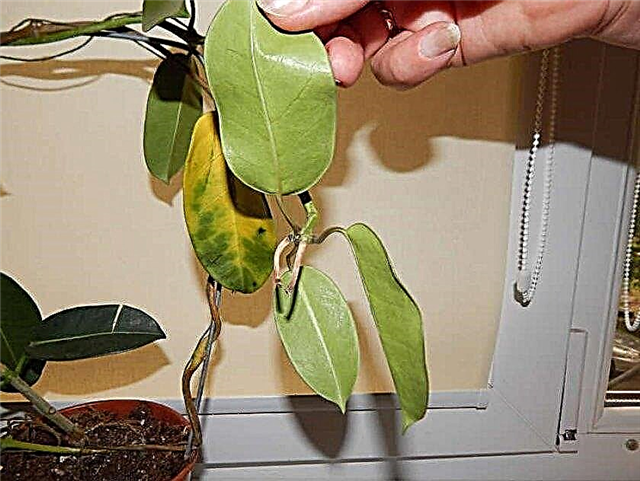
- Leaf fall. The reason is cold water during irrigation and too dry air in the room. To save the hoya, the air in the room is intensely moistened, and only warm water is used for irrigation.
- Slowing growth, small leaves. In winter, such symptoms should not be alarming - the hoya simply goes into a state of rest. In spring and summer, the plant may grow poorly due to a lack of nitrogen-containing fertilizers. To fix the problem, top-dress.
- Powdery Mildew A sign of this fungal disease is a white coating on the leaves, which subsequently spreads to the stems and inflorescences. The problem arises as a result of poor ventilation and dry air. To treat a flower, it is treated with a copper-soap solution and the humidity in the room is increased.
- Root rot. It occurs with excessive watering, especially in the cold season and often leads to the death of the plant. The hoya is removed from the old pot, the roots are treated with Bordeaux liquid and the flower is transplanted into a new substrate, reducing watering. But this procedure does not guarantee that the plant will be able to save. Therefore, it is better to cut off a few cuttings and root them to grow a new flower.
Is it possible to keep at home: myths and reality
Signs and superstitions are associated with the hoya plant. It is believed that this flower drives all adult men out of the house, therefore it affects couples badly. There is an opposite opinion, according to which wax ivy strengthens the family and brings happiness to the house.
Did you know? Hoya Locki grows in Vietnam and is protected from destruction, and its inflorescences exude a sweet aroma of chocolate.
- The flower has such useful properties:
- cleans the air of harmful substances;
- reduces negative emotions such as anger, envy and resentment;
- helps to cope with depression and nervous tension;
- leaves are used to treat acne on the skin.
- The cons of hoya are:
- toxicity of juice, leaves and flowers - the poison causes irritation on the skin, inflammation in the eyes and poisoning in contact with the gastric mucosa;
- strong aroma of hoya flowers can cause a headache.
Each person decides for himself whether or not to believe one or another opinion about the Hoya. But often, because of these superstitions, a flower is grown only in office premises.
Hoya belongs to poisonous plants, but its bright inflorescences and powerful creeping branches will decorate any interior. Subject to safety precautions and simple recommendations for flower care, it can be grown for vertical gardening of walls in homes and offices.







 Scabbard, aphid and spider mite
Scabbard, aphid and spider mite

